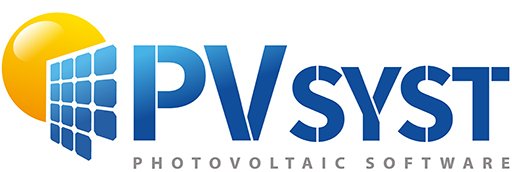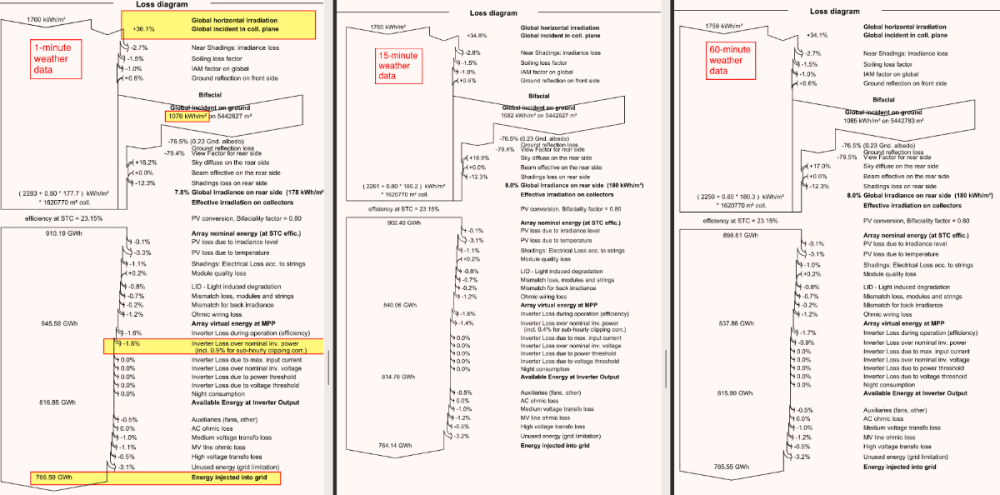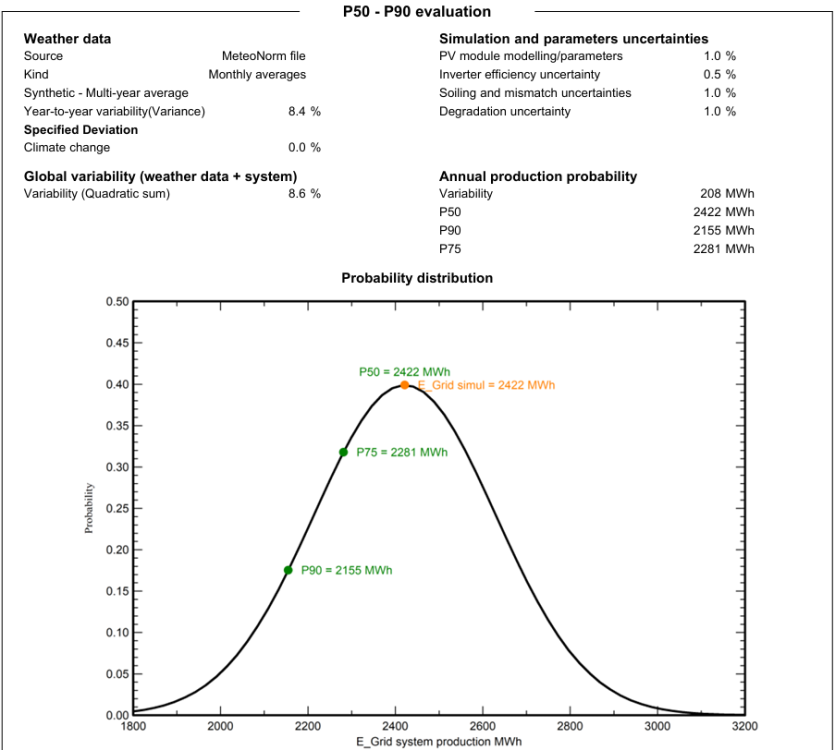All Activity
- Today
-
Glad to help ! I see, however I still fail to see the purpose of this request, sorry. If the inverter clips at a given time, this means that at that time the PV production reaches the clipping threshold at that time. If you model the PV production based on the measured data (not from a TMY), the clipping time should at least roughly correspond to the reality. Same thing with the module temperature, if you were to model using the real historical weather data, the temperature of the modules, measured and simulated, should at least roughly match. Let us know if I missed something about your intentions with the simulation.
-
Michele Oliosi started following Differing POA Irradiance Depending on Weather Granularity
-

Differing POA Irradiance Depending on Weather Granularity
Michele Oliosi replied to JStief's topic in Simulations
Dear JStief, This is puzzling, especially because PVsyst will average data to 1-hour steps anyway, meaning that the modeling should be identical. The first thing that springs to mind is that the 1-min, 5-min, and 60-min files are not simply related by averaging. In other words, if you average the 1-minute data, you won't obtain the 60-min data. Is there a chance to check that ? -

A Problem with Big Power Plant Designs in Nb. rectangles in width (X)
Linda Thoren replied to Tohid's topic in Simulations
Hi, Indeed the maximum number of rectangles is limited to 100. However, in most cases—even for large-scale projects—each table typically contains only a few strings, so this limitation normally is not issue. For example, if each table includes four twin half-cell panels arranged in portrait orientation, and each row of panels in the table corresponds to a single string, then the table would require eight rectangles in width (x-direction). Could you please clarify how the system layout is defined in your example? You can find more details about the partition model in the following help page https://www.pvsyst.com/help/project-design/shadings/electrical-shadings-module-strings/index.html?h=partition -
Hoffmann joined the community
- Yesterday
-
gibijyly joined the community
- Last week
-
The Problem in PVSyst 7.4: When designing a large-scale power plant, we run into a big problem in the "Near Shading" tab. The software does not allow us to put more than 100 for the "Nb. rectangles in width (X)". This is a major limitation for large layouts. We know that the "Module Layout" tool is the accurate way to model things, but it is too slow and not practical for very big systems of several megawatts. It also doesn't fix the core problem we have with the partition limit in the first step.
-
Tohid joined the community
-
JStief started following Differing POA Irradiance Depending on Weather Granularity
-
Hello - I recently ran a test on the same variant using 60-minute, 15-minute, and 1-minute TGY (typical GHI year) data from a satellite weather provider. The 15-minute Egrid was less than 60-minute (due to sub-hourly clipping), but (surprisingly) the 1-minute result was the highest out of the three. This was due to higher Global Incident in coll. plane (POA, plane of array). The top line GHI varied by one - due to rounding differences per the satellite provider explanation. I'm hoping to better understand why the pvsyst simulation would have had this result. I reviewed the PhiAng and the hourly tracking angles are identical. See image below of the three different weather file runs' waterfalls. Thank you 1min, 15min, 60min pdf.pdf
-
Sanda Vulindlu joined the community
-

Power sharing between MPPTs and within inverter
Linda Thoren replied to ShivamPandey's topic in How-to
Hello, If all the strings have the same length you can indeed use the Power sharing within the inverter. The two options should give the same result. -
Hanaa joined the community
-
Tina Dornbusch joined the community
-
If we need to connect 6 strings of 15 modules to three MPPT inverters, which option should we use between Power sharing between MPPTs and within the inverter Should we choose independent MPPTs and or a single inverter with power sharing within the inverter? Technically, no power sharing will be done as all MPPTs havethe same amount of power, but does choosing between these make or create any difference in simulations or productions?
-
Hi, Changing these values in the project settings will not affect the simulation results — it will only have an impact in the triggering of the error message. The error message is designed to protect the inverter from potential damage when the absolute maximum input voltage is exceeded. In this situation, there is a real risk of damaging the inverter.
-
Overriding string length configuration
Mohammed Sukhtian replied to Mohammed Sukhtian's topic in How-to
Hello Linda, will this have any impact on the panel performance in the simulation? in my example I have to rise the temperature to 20 deg C , to be able to increase the string length to 30. while in practical conditions the lowest temperature is 5 deg C. Thanks -
Hi, these two factors are directly related to the components in your system as well as the weather. Directly setting a clipping time or a maximum module temperature would be unrealistic, and is not possible in PVsyst. Instead, you can consider changing the components such as changing inverter model or PV module, or also changing the system layout.
-
Ramoeti Mgavu joined the community
-
m.hajda joined the community
-
Halvor Krunenes joined the community
-
Dear PVsyst Support Team, I am currently working on two ground-mounted PV sites, and I have encountered two different issues during the simulations: Inverter clipping time – In one of the sites, the inverter reaches clipping quite early, around 11:30 AM. Is there any way within the simulation settings to define or adjust the specific time when inverter clipping occurs? Module temperature limitation – In another site, the module temperature exceeds 45°C, which significantly reduces the system’s performance. Is it possible to set or limit the module’s maximum temperature within the simulation parameters? Thank you in advance for your assistance.
-
Alex.el-mor joined the community
-
Hello, You set the Lower temperature for Absolut Voltage limit in the Project Settings, Design conditions window. Kind regards
-
Dear Nikoloz, You can follow this tutorial: Regards,
-
It is suggested that you deal with systems using hybrid inverters by defining a battery system with a consumption profile. You still have to select an inverter. Do you have to try and find a non-hybrid inverter that has all the characteristics such as number string inputs, number of MPPT's min and max voltages as the hybrid inverter you want to use?
-
Hello, I am facing an issue with a client , where they want to investigate if 30 modules per string is possible , the combination of Huawei 330KTL-H1 and Tongwei 715Wp TWMNF-715WP vs Jinko Solar JKM-710Wp 66HL5-BDV-710N , the project is Mallorca-Spain, using trackers. Huawei explains that PVsyst relies only on temperature for string length calculation , while Fusion solar combines temp. + Irradiance + Diode effect, and thus allowing 30 Modules per string. I would like to know if there is a way to override the string length in Pvsyst cause its not allowing me to simulate this scenario. looking forward to hearing from you Kind regards M.A. Sukhtian
-
The P50-P90 is fully described in the following youtube tutorial:
-
Hello, From my experience working in the utility scale solar design space, I recommend averaging meteorological data from multiple sources. This approach helps improve the reliability and accuracy of the resource assessment by minimizing the influence of anomalies, data gaps, or biases that may exist in individual datasets. Using averaged data provides a more representative long term climate profile for the site, leading to more robust energy yield estimates and better-informed design and financial decisions. Happy to share a tool that quickly does the computation.
-
I have here this P50-P90 report. What is the meaning of variability and why does it have a value of 208 MWh?
-
Hello is it possible to import KMZ or KML file in to 3d shading scene as a ground object? for example
-

Evaluation of the Impact of Environmental Factors on PV Performance
Linda Thoren replied to Nathan237's topic in Simulations
Hello, In the following youtube tutorial you find how to define the thermal parameters, soiling losses etc. Kind regards, -
Nathan237 started following Evaluation of the Impact of Environmental Factors on PV Performance
-
Hello 😊, I would like to use the PVSYST software to evaluate the impact of environmental factors (wind, dust, temperature, etc.) on the performance of photovoltaic panels in the city of Douala. However, I don’t know how to proceed with the software to carry out this work. Indeed, I have taken the time to go through some of the tutorials available in the courses offered by PVSYST, but I still don’t see how to do it, and the deadline for this work is very close. While waiting for a response from you, I hope that someone on this forum will be able to help me. Thank you.
- Earlier
-
Hello, Indeed, since successive losses will affect the active power, the power factor at the injection point may differ slightly from what you entered in PVsyst. Kind regards
-
Hello, did you change the sizes definition or sensitive area dimensions of the created tables after filling the zone? For a better analysis of your issue you could send the export of your project to support@pvsyst.com so we can provide a precise answer.









